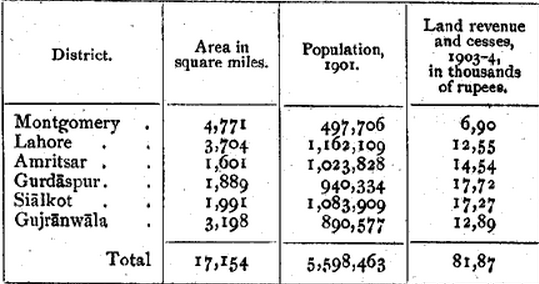Lahore Division, 1908
This article has been extracted from THE IMPERIAL GAZETTEER OF INDIA , 1908. OXFORD, AT THE CLARENDON PRESS. |
Note: National, provincial and district boundaries have changed considerably since 1908. Typically, old states, ‘divisions’ and districts have been broken into smaller units, and many tahsils upgraded to districts. Some units have since been renamed. Therefore, this article is being posted mainly for its historical value.
Lahore Division
Central Division of the Punjab, stretching roughly from the Chenab to the Sutlej. It lies between 29° 58' and 32° 51' N. and 72° 27' and 75° 56' E. The Commissioner's head- quarters are at Lahore and Dalhousie. The total population of the Division increased from 4,696,636 in 1881 to 5,321,535 in 1891, and 5,598,463 in 1901. The total area is 17,154 square miles, and the density of population is 326 persons per square mile, compared with 209 for British territory in the Province as a whole. In 1901 Muham- madans numbered 3,332,175, or 60 per cent, of the total ; while other religions included Hindus, 1,567,402 ; Sikhs, 661,320 ; Jains, 5,507 ; Buddhists, 6; Parsis, 228; and Christians, 31,815, of whom 25,248 were natives.
The Division contains six Districts, as shown below :-
Gurdaspur includes a few square miles of mountainous country, enclosing the hill station of Dalhousie (highest point, 7,687 feet) ; but otherwise the Division is flat. It contains 9,869 villages and 41 towns, of w'hich the largest are Lahore (population, 202,964, including cantonment), Amritsar (162,429), Sialkot (57,956), Gujranwala (29,224), Batala (27,365), and Kasur (22,022). In commercial importance Lahore and Amritsar dwarf all other towns in the Division, but Sialkot and Batala are considerably more than local centres. The history of Lahore, and the religious importance of Amritsar, are described under those cities.
Besides the administrative charge of six British Districts, the Com- missioner of Lahore has political control over the Native State of Chamba, which has an area of 3,216 square miles and a population (1901) of 127,834.
